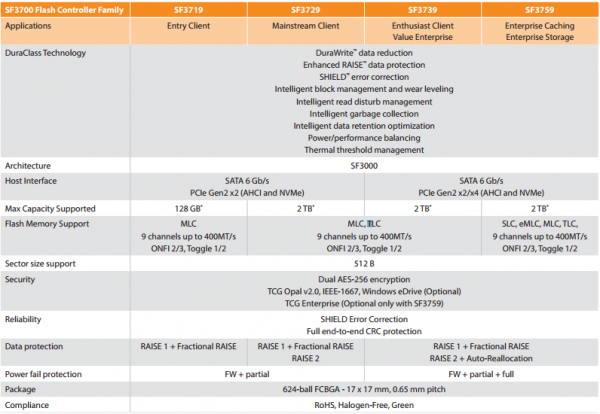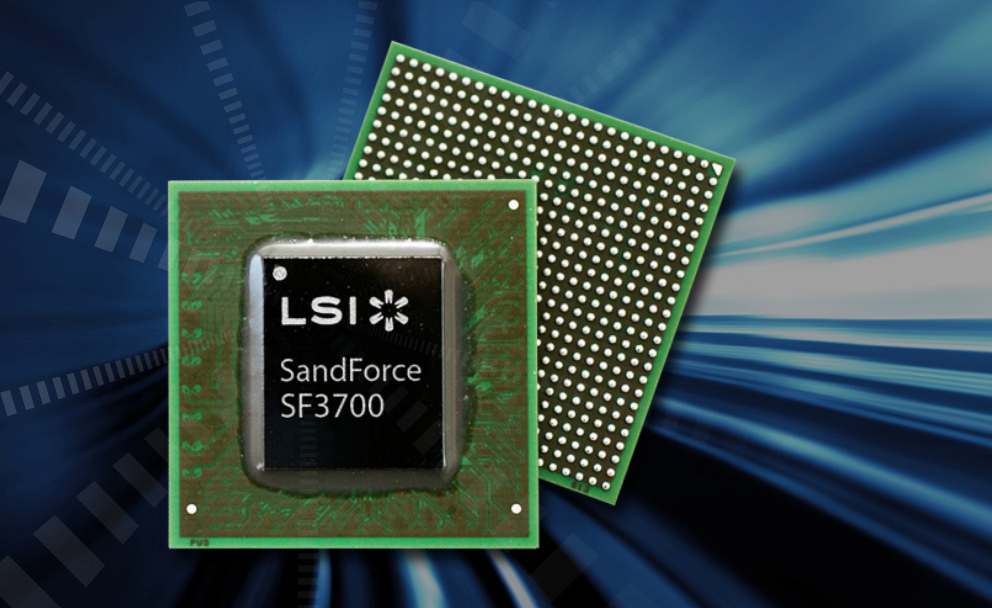Recently LSI announced the third generation of their SandForce flash controllers this week. LSI purchased SandForce some time ago and is using the acquired company to push into areas it previously had not played. The new SF3700 series controllers allow for faster, higher capacity storage than previous generations. It also introduces a new 6Gb/s PCIe Gen2 design, bringing the fastest connection to and from the SSD. So what else is new in the LSI SF3700?
Key Features of the new LSI SandForce SF3700 Flash Controllers
The new SandForce Flash Controllers have several new features beyond the introduction of the new PCIe architecture.
- Potential capacity increased to 2TB per drive (important for new products)
- Built-in Error Correction
- Built-in Endurance features
- Dual AES-256 drive level hardware encryption
- Failed power protection
- Native PCIe and SATA Interfaces: M.2 form factor cards designed with the SF3700 flash controller’s industry-only dual PCIe and SATA interface can use a simple manufacturing jumper to select the final desired interface for better inventory and cost management. The SF3700 family’s PCIe interface supports AHCI and NVMe protocols to enable both legacy applications of PCIe flash and efficient NVMe flash storage application acceleration solutions.
Many of these features have been found in previous generations SandForce controllers and are due to their proprietary compression algorithms. One of the biggest improvements in this generation is the new SandForce DuraWrite endurance technology. They’re doing everything from limiting write amplification to adding SHIELD error correction to extend memory life.
“From our everyday lives to the hyperscale datacenter, flash storage solutions are transforming the speed and efficiency of data storage,” said Huibert Verhoeven, vice president and general manager, Flash Components Division, LSI. “The SF3700 family brings a new architecture, designed from the ground up to deliver unmatched flash performance and the longevity required to drive current and future portable client computing, enterprise and big data applications.” In addition, LSI is also introducing ultra low power modes for PCIe and SATA interfaces. As we have seen with the recent Avoton products, low power is king. For these applications, saving a single watt per system can mean 3% higher rack density.
LSI SandForce SF3700 Data Protection, Security and Reliability
LSI is also bringing unparalleled data protection and security technology to the new flash controllers. They have a proprietary technology called RAISE, which stands for Redundant Array of Independent Silicon Elements. It protects the drive after an error occurs, so in a way it is similar to RAID protection, but on a single drive. RAISE protects against page, block and full die failures in a single drive environment.

When it comes to security, LSI is also adding several new features to this generation. In addition to AES-256 encryption, they provide optional support for TCG Opal and eDrive protocols for the security management of applications.
Greater Benefits for Drive Manufacturers
The LSI SandForce SF3700 Flash Controllers bring huge benefits for drive manufacturers. In addition to being the first PCIe Gen2 flash controller, it also brings SATA 6Gb/s functionality in one design. This allows manufactures to use one Controller for either a PCIe connection or a SATA interface. They are also smaller, more power efficient, and cheaper to boot.
To this end, LSI released several controllers in the SF3700 family to meet specific industry needs.

More on these controllers as we see drives become more widely available.
Conclusion
So what does this mean for businesses and consumers? It means faster SSD drives, with higher capacity. It also means cheaper SSD drives, which is something people have been asking about for a while.
The biggest barrier that Solid State Drives have faced over the last five years is that they have been extremely expensive, and extremely low on capacity. The cost per gigabyte was astronomical (and is still much higher than that of mechanical hard drives). Both NANDFlash and Controllers like the SandForce 3700 are much cheaper than they used to be, which makes it easier for manufactures to pass those savings on to business and consumers.
What all this means is that SSDs will become more and more prevalent in datacenters in the next few years. This will allow for faster performance, and smaller servers.
Questions or comments? Talk back in the comment section below or in the forums.





The trend towards PCIe disk interfaces in laptops continues, with 1GB/s/disk begin the new normal and 2GB/s coming soon. And how long will IT let laptops have faster disk IO than their servers or enthusiasts let laptops outpace gaming desktops? So I see a (very welcome) march toward PCIe as a standard disk interface, and I like it!
Now who messed up and let these only support up to 2TB disks?